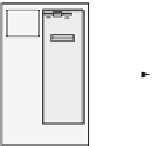Biomedical Engineering Reference
In-Depth Information
Provide administrators, managers, and caregivers
with accurate and on-demand reports and automatic
alerts via pagers, e-mail, phone, and intelligent-software
agents
username and password used by the other applications
that authenticate to the central user log-in repository.
The integrated data-mining and report module con-
sists of a number of standard reports that take advantage
of the data warehouse nature of the BMD. These reports
include, but are not limited to, a historical census report,
a real-time census report, a bed manager report, a physi-
cian discharge report, and a discharge compliance report.
In addition, access to the data by industry standard
report writers, such as Crystal Reports and Access, give
technical users the ability to create complicated or spe-
cial reports as desired. For example, the BMD offers
extensive ad hoc reporting capabilities ranging from
length of stay (LOS) and ''Care Day'' metrics to asset
management analyses (on beds and patient-monitor uti-
lization), to biosurveillance reports that have been
requested by state and federal organizations such as the
Department of Public Health and the Centers for Dis-
ease Control and Prevention.
The utility and configuration module gives system op-
erators the ability to administer BMD users (e.g., to add
new users and to modify new or existing user security
settings); to administer service, unit, rooms and beds (e.g.,
to add or modify clinical services, units, rooms, and beds,
and their inter-relationships); to define automated alert
thresholds; and to configure unit floor plan diagrams.
The embedded back-up utility module consists of
a local version of the bed-management database that is
How it works
The BMD is accessible via a web browser or via a client
application. The supporting architecture of the BMD
system is a standard N-tier server-based system, which,
depending on the end users' needs, consists of one or
more of the following: A web server, an application
server, a database server, and an ADT interface server.
Key information from the hospital's ADT system is
automatically fed to the BMD via a Health Level Seven
(HL7) data stream. The system has been designed to
accept inputs from patient monitoring and nurse-call
networks.
Figure 5.5-3
illustrates the flow of in-
formation from the ADT system to the user's desktop.
The system typically receives up to 12,000 transaction
messages per day, which are parsed into appropriate
data elements by an HL7 parser and are stored on
a database server.
The log-in authentication module accesses a hospital's
central user log-in repository to validate the user's log-in
information. This module enables single-user sign-on
(SSO) capability by providing a user with the same
Web Server
IC
Intranet
or
Internet
ADT
Interface
Se
rver
ADT
System
Client-
Server
IDC
IC
Appl
ication
Se
rver
HL7
Datastrea
m
C
lient-
Serve
r
Client-
S
erv
er
Bed
Management
Database
Server
Client-
Server
Emergency
Backup
Module
Client-Server
Log-In
Authentification
Module (SSO)
Bed
Placement
Module
Security
Module
Utility and
Configuration
Module
Data Mining and
Reporting
Module
Data Import
and Export
Module
Communications
and Notification
Module
Figure 5.5-3 System diagram: The BMD consists of four major components: the ADT interface, the database server, an application
server and a web server. The system has been designed to interface with any ADT system that provides an HL7 interface and utilizes
TCP/IP as a communication protocol.






















































































































































































































































































































































































































































